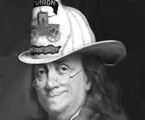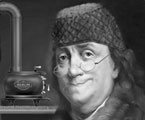 Benjamin Franklin was chosen as the main character in our Code Check illustrations for a number of reasons. The "First American's" insatiable curiosity, scientific genius, and civic-mindedness drove him to study fire safety, safe exiting, public sanitation, improved heating methods, and of course, electricity. Franklin made major contributions to each of the four main disciplines of building inspection: Building, Plumbing, Mechanical, and Electrical.
Benjamin Franklin was chosen as the main character in our Code Check illustrations for a number of reasons. The "First American's" insatiable curiosity, scientific genius, and civic-mindedness drove him to study fire safety, safe exiting, public sanitation, improved heating methods, and of course, electricity. Franklin made major contributions to each of the four main disciplines of building inspection: Building, Plumbing, Mechanical, and Electrical.
Franklin's first attempt to safeguard the public through building codes came in1735 with his call for minimum standards in the design of fireplace hearths, hearth extensions, and combustible material clearance. The principles Franklin proposed live on in the modern building codes, and are discussed in the fireplace sections of our books.
 A main theme of the building codes is protection against fire, and safe egress from a building. In 1735, Franklin organized the first volunteer Fire Department in Philadelphia, a model for many of our modern fire departments. He also understood the importance of building design in slowing the spread of a fire and was proud that his final home - built after his return from France in 1785 - did not have concealed spaces where fire could spread and "none of the wooden work from one room communicates with the wooden work of any other room." By judicious use of plaster, Franklin anticipated the fire-stopping rules. He also took an interest in designing stairways that were the proper pitch.
A main theme of the building codes is protection against fire, and safe egress from a building. In 1735, Franklin organized the first volunteer Fire Department in Philadelphia, a model for many of our modern fire departments. He also understood the importance of building design in slowing the spread of a fire and was proud that his final home - built after his return from France in 1785 - did not have concealed spaces where fire could spread and "none of the wooden work from one room communicates with the wooden work of any other room." By judicious use of plaster, Franklin anticipated the fire-stopping rules. He also took an interest in designing stairways that were the proper pitch.

One of Franklin's early inventions was the Franklin Stove, still called by his name today. By the mid-1740s, firewood was already scarce in the Philadelphia area, and air pollution was beginning to be a problem. Franklin's design in 1744 retained more heat than the fireplaces or stoves that were then current, thus reducing the demand for wood. Ever the altruist, he refused to patent his invention and insisted on "giving it to the world". Franklin never lost interest in the subject. In 1785, concerned over the polluting effects of coal, he designed another stove that burned soft coal and consumed its own smoke.
 An unusual aspect of Franklin's personality, at least by the standards of the 18th century, was his concern for personal hygiene. From his youth he was an avid swimmer, and in his adult life he bathed as often as once a week--a practice considered scandalous at the time. Franklin not only brought the first bathtub to America, but he improved its design and spent much of his time reading and writing while soaking. His concern for sanitation went beyond his own personal needs, and he was instrumental in creating America's first public sewer system in Philadelphia.
An unusual aspect of Franklin's personality, at least by the standards of the 18th century, was his concern for personal hygiene. From his youth he was an avid swimmer, and in his adult life he bathed as often as once a week--a practice considered scandalous at the time. Franklin not only brought the first bathtub to America, but he improved its design and spent much of his time reading and writing while soaking. His concern for sanitation went beyond his own personal needs, and he was instrumental in creating America's first public sewer system in Philadelphia.
 Of all of Franklin's scientific accomplishments, the best known is his lightning rod. After correctly hypothesizing the nature of lightning in 1750, his famous kite experiment in 1752 confirmed that lightning was a form of electricity and could be directed to the earth through rods and conductors. The principles of grounding date back to him. To this day, passive lightning protection systems are referred to as "Franklin" systems. Franklin coined the word "battery," and was also the first to describe a positive and negative charge in electrical systems. As luck would have it, his own house was hit by lightning and saved by his invention. Franklin can also be said to be the "First Electrician", another word he introduced.
Of all of Franklin's scientific accomplishments, the best known is his lightning rod. After correctly hypothesizing the nature of lightning in 1750, his famous kite experiment in 1752 confirmed that lightning was a form of electricity and could be directed to the earth through rods and conductors. The principles of grounding date back to him. To this day, passive lightning protection systems are referred to as "Franklin" systems. Franklin coined the word "battery," and was also the first to describe a positive and negative charge in electrical systems. As luck would have it, his own house was hit by lightning and saved by his invention. Franklin can also be said to be the "First Electrician", another word he introduced.
The purpose of the building codes, as stated in the IRC, is to "safeguard the public." At Code Check, we feel the contributions of Benjamin Franklin are still alive in today's building codes and are carried on by code-making organizations and the people who practice those codes.
